

Folk songs come out of constant variations, additions, and modifications that come from each voice that sings them. Kris Kristopherson and Fred Foster wrote “Me and Bobby McGee” for Roger Miller in 1969, later Kristopherson released his own version in 1970. The song was then passed to Gordon Lightfoot and was finally recorded by Janis Joplin days before her death to become the only version of the song to top the charts. This nature of a song being written collaboratively, then passed among a group of musicians comes from traditions of folk songs that were passed back and forth between travelers engaged in a tradition of oral histories. By having multiple authors songs like “Me and Bobby McGee” can hold both the weight and flexibility of many histories and contexts. This is lost in so much of the traditions found in visual art as its history became dominated by Western ideas of perspective and a singular author and eye.
Choosing instead to follow the flexible oral histories found in folk traditions, the drawings in Weeping Laughing Song were generated through a collaboration between Austin Pratt and Tom Wixo as they sent drawings back and forth to each other through the mail between Nevada and Pennsylvania. Emerging from conversations and ideas about the possibilities of drawing since they first met as studiomates in 2015, Pratt and Wixo find great sites of potential in the physicality of drawings as objects, mark-making as a form of touch, the drawing process as a way of searching or uncovering new information, and the spooky “third mind” that occurs within collaboration. These drawings emerged out of responding, mutilating, distorting, focusing, centering, derailing, and fragmenting broken images and idiosyncratic processes; expanding a more open idea of how drawings can be.
Choosing instead to follow the flexible oral histories found in folk traditions, the drawings in Weeping Laughing Song were generated through a collaboration between Austin Pratt and Tom Wixo as they sent drawings back and forth to each other through the mail between Nevada and Pennsylvania. Emerging from conversations and ideas about the possibilities of drawing since they first met as studiomates in 2015, Pratt and Wixo find great sites of potential in the physicality of drawings as objects, mark-making as a form of touch, the drawing process as a way of searching or uncovering new information, and the spooky “third mind” that occurs within collaboration. These drawings emerged out of responding, mutilating, distorting, focusing, centering, derailing, and fragmenting broken images and idiosyncratic processes; expanding a more open idea of how drawings can be.
Link: Austin Pratt & Tom Wixo: “Weeping Laughing Song” interview on KWNK radio

























